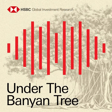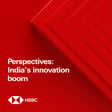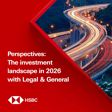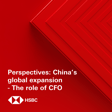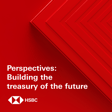Become a Creator today!Start creating today - Share your story with the world!
Start for free
00:00:00
00:00:01

Under the Banyan Tree - India: A New Growth Era in a Top Five Economy
With India having recently overtaken the UK as the world’s fifth largest economy, Fred Neumann talks to Chief India Economist, Pranjul Bhandari, about the modern growth drivers that we think can push GDP beyond its 6% average in recent years. Disclaimer. To stay connected and to access free to view reports and videos from HSBC Global Research click here.
Hosted on Acast. See acast.com/privacy for more information.
Transcript
Introduction to HSBC Global Viewpoint
00:00:00
Speaker
Welcome to HSBC Global Viewpoint, the podcast series that brings together business leaders and industry experts to explore the latest global insights, trends, and opportunities.
00:00:11
Speaker
Make sure you're subscribed to stay up to date with new episodes.
00:00:14
Speaker
Thanks for listening, and now onto today's show.
00:00:16
Speaker
This is a podcast from HSBC Global Research, available on Apple Podcasts and Spotify.
00:00:22
Speaker
Search for HSBC Global Viewpoint or join us via the HSBC Global Banking and Markets page on LinkedIn.
00:00:29
Speaker
However you're listening, analyst notifications, disclosures and disclaimers must be viewed on the link attached to your media player.
India's Economic Resilience
00:00:46
Speaker
Welcome, I'm Fred Newman, Chief Asia Economist at HSBC and you're listening to Under the Banyan Tree where we put Asian markets and economics in context.
00:00:54
Speaker
This week we're putting the spotlight on India, continuing our theme of Asian economies on a positive track despite the various dark clouds that are raining on the global macro parade.
00:01:04
Speaker
Joining me from Mumbai is our Chief Economist Pranjul Bhandari.
00:01:08
Speaker
We've got plenty to talk about, so let's start the show.
00:01:20
Speaker
Well, with growth averaging 6% every year for the past decade, there's no doubting that India's economy has long been on a positive track.
00:01:28
Speaker
But in the current climate, certain stats make particularly impressive reading.
00:01:31
Speaker
For one, its benchmark stock index, the Sensex, has actually risen over the past year.
00:01:36
Speaker
Compare that to the S&P 500, which is down around 15%.
00:01:38
Speaker
Inflation remains a challenge, but with foreign direct investment close to record highs, there are clear signs that investors are optimistic on the macro outlook.
00:01:48
Speaker
In fact, India just overtook the UK to become the world's fifth largest economy.
00:01:52
Speaker
So let's bring in Pranjal to help us put all of this into context.
00:01:56
Speaker
Pranjal, welcome to the podcast.
00:01:58
Speaker
Hi, Fred.
00:01:58
Speaker
Great to be here.
00:02:00
Speaker
So Pranjal, help us set the scene a little bit on
Economic Recovery and Challenges
00:02:04
Speaker
India.
00:02:04
Speaker
We had clearly a pandemic that hit India hard.
00:02:07
Speaker
We've seen soaring oil prices.
00:02:10
Speaker
How has growth held up in recent quarters?
00:02:13
Speaker
Yeah, I think 2022 has been good for growth so far.
00:02:17
Speaker
You know, we came out of the lockdowns in March and ever since consumption is rising as households are consuming services which they were not able to consume in the last couple of years.
00:02:28
Speaker
There has been a huge amount of formalization over the pandemic period.
00:02:32
Speaker
Tax revenues for the government is very high.
00:02:34
Speaker
The government is spending it, particularly on public capex, which is very encouraging.
00:02:40
Speaker
And on the sidelines, even private capex has begun to recover a bit.
00:02:44
Speaker
So overall, I would say the last couple of quarters have seen decent recovery coming out of the pandemic.
00:02:51
Speaker
So we're seeing decent recovery out of the pandemic, but then the global economy, there's sort of very dark clouds on the horizon.
00:02:58
Speaker
We've seen certainly the Fed raise interest rates very rapidly.
00:03:02
Speaker
We're also seeing a slowdown in global trade.
00:03:05
Speaker
How does that affect the Indian economy overall?
00:03:10
Speaker
How worried are you about these trends and the impact on growth in India?
00:03:14
Speaker
Yeah, I do think that the next couple of quarters will see growth softening.
00:03:19
Speaker
And the primary reason will be exports.
00:03:21
Speaker
A lot of people don't realize this, that exports is a very important driver for India's growth.
00:03:27
Speaker
In fact, coming out of the pandemic, exports has been the biggest driver of India's growth recovery.
00:03:34
Speaker
So if global growth slows, if trade volumes slow, then India's exports growth and India's GDP is also likely to slow.
00:03:41
Speaker
In fact, we're already seeing some of the export volumes beginning to slow since August.
00:03:48
Speaker
That's one thing that could soften growth.
00:03:49
Speaker
The other thing that could soften growth is just pent up services demand ending.
00:03:55
Speaker
At some point, it comes to an end.
00:03:58
Speaker
This time in particular, it's been cut short by high prices, high inflation.
00:04:02
Speaker
So I think the combination of slower exports and slightly weaker private consumption will mean softer GDP growth in the next couple of quarters.
00:04:12
Speaker
And how exposed is India to rising US interest rates?
00:04:16
Speaker
We've seen the currency weaken, of course, on the back of this.
00:04:20
Speaker
Is that something that really is a major drag on the Indian economy or is it really more domestically driven and it matters what happens to local inflation and local interest rates?
Impact of Global Factors on India
00:04:32
Speaker
Yeah, what the Fed does definitely matters.
00:04:34
Speaker
But I would argue here that what's happening domestically matters more.
00:04:38
Speaker
And I think one thing to look out for is inflation.
00:04:41
Speaker
Inflation has been running higher than the RBI's 4% target and even higher than the RBI's upper bound of 6% for several months now.
00:04:51
Speaker
And the RBI has had to raise rates for simply bringing down inflation.
00:04:56
Speaker
So I think that's been a larger driver of India's rate policy in the last couple of months.
00:05:04
Speaker
Now, the other external angle, of course, is energy, right?
00:05:08
Speaker
India is a huge net energy importer.
00:05:11
Speaker
We've seen big disruptions to global energy markets over the past year.
00:05:17
Speaker
How disruptive has that proven for the Indian economy?
00:05:21
Speaker
And are you worried about energy prices going forward?
00:05:25
Speaker
Yeah, so look, India is a huge importer of oil.
00:05:29
Speaker
And with oil prices having risen so much, India's trade deficit has widened.
00:05:34
Speaker
In fact, I would say that today, the current account deficit is twice as high as it should be.
00:05:40
Speaker
And I think that is generally a problem.
00:05:42
Speaker
So yes, rising commodity prices globally have created a problem for India.
00:05:48
Speaker
But having said that, India is also trying to do a lot of things to increase renewable energy, to reduce its dependence on imports.
00:05:58
Speaker
There have been a lot of ambitious targets.
00:06:00
Speaker
renewable energy, which India has been able to meet over the last couple of years.
India's Renewable Energy Progress
00:06:05
Speaker
So, Pranjit, what are some of the key initiatives that you're tracking at the moment when it comes to alternative energy build out in India?
00:06:13
Speaker
There's a lot going on on that front.
00:06:15
Speaker
India had many targets on renewable energy in terms of installed capacity, and it's actually met many of these targets even before time, and that has been very impressive.
00:06:26
Speaker
Many corporates, private sector corporates are working on futuristic sectors like green hydrogen.
00:06:32
Speaker
There are ambitions that India becomes a green hydrogen hub in the region.
00:06:38
Speaker
And then, of course, there are a lot of government subsidies on sectors such as EVs and solar panels.
00:06:44
Speaker
So a lot of excitement and a lot of activity is happening on the green transition for India.
00:06:51
Speaker
Thank you, Pranjul.
00:06:51
Speaker
This is probably a good point to take a quick break.
00:06:54
Speaker
And when we come back, we'll talk about the medium-term outlook for the Indian economy and some of the structural growth drivers that will hopefully help raise India's growth over time.
Driving Growth: Tech and Infrastructure
00:07:17
Speaker
Pranjal, we've talked about the near-term outlook, some of the challenges, external and internal, for the Indian economy, but let's focus more on the medium term.
00:07:26
Speaker
How optimistic are you about India's growth rate?
00:07:31
Speaker
We kind of noted at the beginning that, on average, the Indian economy has grown by 6% over the past decade.
00:07:39
Speaker
Is that a number that you think is sustainable going forward?
00:07:43
Speaker
Yes, I think there are a lot of new growth drivers that have emerged over the pandemic period.
00:07:49
Speaker
And it makes me very excited about India's medium term growth potential.
00:07:53
Speaker
One of them is the rise of high tech goods and services exports from India.
00:07:59
Speaker
Now, we all know the story of IT services exports, which is expanding now.
00:08:04
Speaker
But there's also a lot of excitement in high-tech goods exports, for instance, mobile handsets, drugs and pharmaceuticals, automobile parts, specialized machinery.
00:08:14
Speaker
And let me tell you that in each of these sectors, India has actually been gaining global market share since 2017.
00:08:20
Speaker
So that is one sector which I'm excited about that I think can propel growth higher over the next decade.
00:08:28
Speaker
And how would that play out domestically?
00:08:30
Speaker
You talked about high tech exports of goods and services, but how does it really impact the domestic economy?
00:08:37
Speaker
Is there a productivity gain?
00:08:39
Speaker
Are there startups?
00:08:41
Speaker
Is there kind of a rewiring of the economy domestically as well?
00:08:46
Speaker
Yeah.
00:08:46
Speaker
So look, another new sector of growth is the startup ecosystem, which is based on India's quite impressive public digital infrastructure.
00:08:56
Speaker
Now, there are many startups that are sprouting, you know, based on India's young demographics, a very digitally savvy population.
00:09:03
Speaker
These startups are now taking up bigger and bigger challenges to provide answers to many real economy problems, ranging from the services sector to manufacturing, digitization of manufacturing, and even agriculture, for instance, digitization of ag tech.
Reforms and Investments in India
00:09:19
Speaker
So a lot of exciting startups are happening and our sense is,
00:09:22
Speaker
that these can really change a lot of the domestic ecosystem, give rise to new jobs, to futuristic capex, and basically higher GDP growth over the next decade.
00:09:35
Speaker
So the way you describe this is really an economy that's coming into its own, obviously, tremendous human talent in India, technologically very savvy.
00:09:45
Speaker
But in the past, India has also been held back by sort of lack of infrastructure, for example.
00:09:50
Speaker
So the potential was always there, but some of the hard infrastructure, for example, was lacking.
00:09:55
Speaker
Do you see that changing going forward?
00:09:58
Speaker
Is there a lot happening on the ground to kind of
00:10:00
Speaker
build the underlying infrastructure to allow kind of the improve the ecosystem for some of this this tech revolution that you're talking about to to to thrive?
00:10:10
Speaker
Yeah.
00:10:11
Speaker
So on the one hand, you know, many of these digital startups are providing digital solutions to physical problems.
00:10:18
Speaker
For example, think about e-commerce.
00:10:20
Speaker
You know, the goods and services are brought to your doorstep if the infrastructure is not good enough for you to go and access the goods and service yourself.
00:10:28
Speaker
So in a way, you know, digital solutions are making up for some of the physical deficiencies in the economy.
00:10:34
Speaker
But having said that, it's also important to get a lot of the reforms going.
00:10:39
Speaker
And my sense is that India has been reforming quite a bit over the last decade.
00:10:44
Speaker
As in, you know, there's been the GST, goods and services tax reform.
00:10:48
Speaker
There's been the insolvency and bankruptcy code reform.
00:10:51
Speaker
There has been a reform to clean up the real estate sector.
00:10:55
Speaker
The entire public digital infrastructure has stood up in the last five to 10 years.
00:11:00
Speaker
The government, interestingly, is spending a lot more on infrastructure investment now than it was a decade ago.
00:11:06
Speaker
And balance sheets of corporates and banks are in a much stronger position now than they were a decade back.
00:11:11
Speaker
So I think a lot of reforms are also happening alongside the emergence of the new sectors that I spoke about.
00:11:19
Speaker
And all of this together makes me excited about India's medium-term growth potential.
00:11:24
Speaker
So a lot of it is technologically driven.
00:11:27
Speaker
You mentioned alternative energy, you mentioned startups, you mentioned digital solutions to potential infrastructure bottlenecks, which would all help increase growth.
00:11:37
Speaker
But from a global perspective, there's always been this suggestion that maybe India could step up its role in global supply
India in Global Supply Chains
00:11:47
Speaker
chains.
00:11:47
Speaker
We've certainly seen a large rise in foreign direct investment.
00:11:53
Speaker
How much do you think India can actually replicate some of the model we've seen elsewhere in Asia where it integrates itself more closely into global manufacturing supply chains?
00:12:05
Speaker
Do you see any evidence of that coming through?
00:12:08
Speaker
Yeah, I think where India's growth trajectory has differed from many other emerging countries is that it has gone on to services much faster than others.
00:12:19
Speaker
As in today, I would say that the growth in its services exports, services as a share of India's GDP is much higher compared to many other emerging markets.
00:12:27
Speaker
So services has been a much bigger driver of growth than manufacturing.
00:12:31
Speaker
And I think some of that will continue over the next decade.
00:12:34
Speaker
But having said that, I also think that manufacturing sector is rising.
00:12:39
Speaker
You know, firstly, there are many digital solutions to physical infrastructure problems that we face, you know, digitization of manufacturing, better access to credit, better access to final markets with e-commerce.
00:12:53
Speaker
But also there are, you know, a lot of reforms that I mentioned, which are helping, you know, manufacturing grow.
00:12:59
Speaker
We've seen India gain global market share in some specialized high-tech goods.
00:13:05
Speaker
It has a long way to go, but I think the first steps have been taken.
00:13:09
Speaker
So, Pranjal, you really describe another very resilient economic story in Asia.
00:13:15
Speaker
It's the fifth largest economy now in the world.
00:13:19
Speaker
It's driven by technological revolution.
00:13:22
Speaker
It's driven by supply chain integration.
00:13:25
Speaker
It's driven by digital solution, alternative energy, and even a consumer market.
00:13:32
Speaker
So where do you then put the trend growth rate over the coming year?
00:13:36
Speaker
We mentioned 6% on average over the past decade.
00:13:39
Speaker
Where would you put it going forward?
Future Growth Expectations
00:13:43
Speaker
Yeah, so look, on the eve of the pandemic, it was a 6% growth economy.
00:13:47
Speaker
My sense is that some of the new sectors like high-tech exports and the startups ecosystem can raise India's GDP growth easily to about 6.5%.
00:13:57
Speaker
And if these startups become more ambitious and they not only focus on services sector, but also get into manufacturing and agriculture and the government doubles up on reforms, then my sense is that over the next decade, India can even see 8% GDP growth.
00:14:13
Speaker
Well, that's a perfect note to end on, Pranjul.
00:14:17
Speaker
8% growth is the target, the magic number 8 for India.
00:14:21
Speaker
It is perhaps within reach in the next few years due to the factors that you describe.
00:14:25
Speaker
And I think a great reminder in the world where we have tremendous turbulence at the moment with energy market disruptions and rising interest rates and slowing trade.
00:14:36
Speaker
that there are really strong, solid, structural stories here.
00:14:40
Speaker
And India certainly is a prime example.
00:14:43
Speaker
So thank you, Pranjal, for coming on to the show.
00:14:46
Speaker
Great to be here, Fred.
Conclusion and Future Episodes
00:14:53
Speaker
And that's it for another week, folks.
00:14:55
Speaker
Always a pleasure to have you with us here under the Banyan Tree.
00:14:58
Speaker
We'll be back again next week, putting Asian markets and economics in context.
00:15:02
Speaker
Till then, take care and all the best.
00:15:16
Speaker
Thank you for joining us at HSBC Global Viewpoint.
00:15:20
Speaker
We hope you enjoyed the discussion.
00:15:22
Speaker
Make sure you're subscribed to stay up to date with new episodes.


